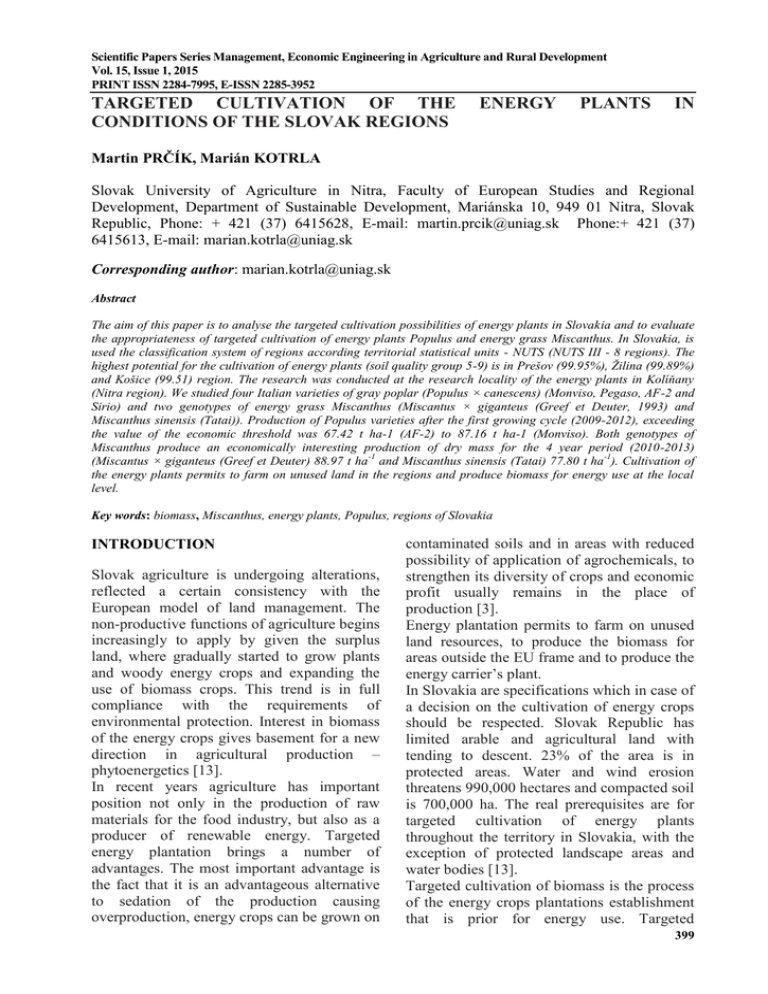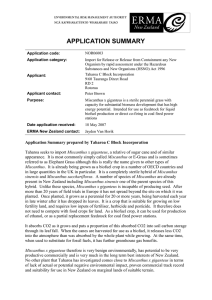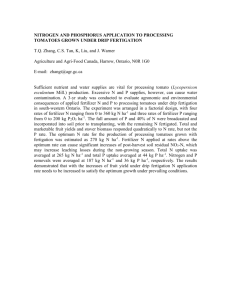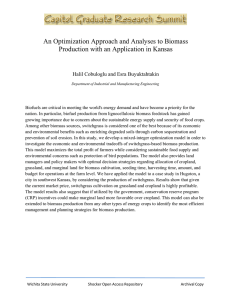Read full article - Scientific Papers Series “Management, Economic
advertisement

Scientific Papers Series Management, Economic Engineering in Agriculture and Rural Development Vol. 15, Issue 1, 2015 PRINT ISSN 2284-7995, E-ISSN 2285-3952 TARGETED CULTIVATION OF THE CONDITIONS OF THE SLOVAK REGIONS ENERGY PLANTS IN Martin PRČÍK, Marián KOTRLA Slovak University of Agriculture in Nitra, Faculty of European Studies and Regional Development, Department of Sustainable Development, Mariánska 10, 949 01 Nitra, Slovak Republic, Phone: + 421 (37) 6415628, E-mail: martin.prcik@uniag.sk Phone:+ 421 (37) 6415613, E-mail: marian.kotrla@uniag.sk Corresponding author: marian.kotrla@uniag.sk Abstract The aim of this paper is to analyse the targeted cultivation possibilities of energy plants in Slovakia and to evaluate the appropriateness of targeted cultivation of energy plants Populus and energy grass Miscanthus. In Slovakia, is used the classification system of regions according territorial statistical units - NUTS (NUTS III - 8 regions). The highest potential for the cultivation of energy plants (soil quality group 5-9) is in Prešov (99.95%), Žilina (99.89%) and Košice (99.51) region. The research was conducted at the research locality of the energy plants in Kolíňany (Nitra region). We studied four Italian varieties of gray poplar (Populus × canescens) (Monviso, Pegaso, AF-2 and Sirio) and two genotypes of energy grass Miscanthus (Miscantus × giganteus (Greef et Deuter, 1993) and Miscanthus sinensis (Tatai)). Production of Populus varieties after the first growing cycle (2009-2012), exceeding the value of the economic threshold was 67.42 t ha-1 (AF-2) to 87.16 t ha-1 (Monviso). Both genotypes of Miscanthus produce an economically interesting production of dry mass for the 4 year period (2010-2013) (Miscantus × giganteus (Greef et Deuter) 88.97 t ha -1 and Miscanthus sinensis (Tatai) 77.80 t ha -1). Cultivation of the energy plants permits to farm on unused land in the regions and produce biomass for energy use at the local level. Key words: biomass, Miscanthus, energy plants, Populus, regions of Slovakia INTRODUCTION Slovak agriculture is undergoing alterations, reflected a certain consistency with the European model of land management. The non-productive functions of agriculture begins increasingly to apply by given the surplus land, where gradually started to grow plants and woody energy crops and expanding the use of biomass crops. This trend is in full compliance with the requirements of environmental protection. Interest in biomass of the energy crops gives basement for a new direction in agricultural production – phytoenergetics [13]. In recent years agriculture has important position not only in the production of raw materials for the food industry, but also as a producer of renewable energy. Targeted energy plantation brings a number of advantages. The most important advantage is the fact that it is an advantageous alternative to sedation of the production causing overproduction, energy crops can be grown on contaminated soils and in areas with reduced possibility of application of agrochemicals, to strengthen its diversity of crops and economic profit usually remains in the place of production [3]. Energy plantation permits to farm on unused land resources, to produce the biomass for areas outside the EU frame and to produce the energy carrier’s plant. In Slovakia are specifications which in case of a decision on the cultivation of energy crops should be respected. Slovak Republic has limited arable and agricultural land with tending to descent. 23% of the area is in protected areas. Water and wind erosion threatens 990,000 hectares and compacted soil is 700,000 ha. The real prerequisites are for targeted cultivation of energy plants throughout the territory in Slovakia, with the exception of protected landscape areas and water bodies [13]. Targeted cultivation of biomass is the process of the energy crops plantations establishment that is prior for energy use. Targeted 399 Scientific Papers Series Management, Economic Engineering in Agriculture and Rural Development Vol. 15, Issue 1, 2015 PRINT ISSN 2284-7995, E-ISSN 2285-3952 cultivation can be regarded as the conventional method of growing with redirect of the energy flow to direct energy consumption. The total agricultural engineering and grower experience without the need for additional inputs in the form of investments in technology and last but not least, the new skills and knowledge is uses in this cultivation. Broadly speaking, we can say that it is a traditional agricultural production, in which the final product is predetermined for industrial use, particularly for energy purposes [10]. Targeted energy plantation is able to provide the expected volume, quality and delivery terms a particular energy source, depending on the need of the customer. The identification of options for the area in terms of production potential is an important factor. Plantations of energy crops in regions of Slovakia can be located on agricultural land that is classified under code estimated pedologic-ecological unit (EPEU) in the fifth to the ninth qualitative groups or on the agricultural land contaminated by hazardous substances, or on the agricultural land falling under code of valuated soil-ecological units in the third or fourth group of quality, where the agricultural land is located in the floodplain areas or waterlogged or exposed to wind erosion [13]. The use of targeted energy crops based on the overall concept of ecosystem services, which are exploited ecosystems - agro-ecosystems that may affect the standard of living of the population of the region [2]. A major benefit of the energy plantations is maintenance and increase of employment in the regions. Establishment of plantations, their care, protection, collection and further processing and production transport can lead to long-term jobs. The advantage is that incomes and derived fuel are remaining by Slovak farmers and entrepreneurs, directly or indirectly linked throughout the logistics chain. Such a pattern can contribute to stop rural depopulation in some regions of Slovakia. Considerable is the fact that such a quality and professionally made crop of energy plants in the country is balanced and contributes to the sustainable stability [10]. 400 The aim of this paper is to analyse the targeted cultivation possibilities of energy plants in Slovakia and evaluate the appropriateness of targeted cultivation of energy plants Poplar species and energy grass Miscanthus for example their cultivation in the Nitra region in south-western Slovakia. MATERIALS AND METHODS In the EU regions is used the classification system of regions according territorial statistical units known by the acronym NUTS (Nomenclature of French des Unites Territoriales Statistiques), prepared by Eurostat, which was created in order to subdivide the territory of the EU to territorial units lower hierarchical degree than are national level, and that the needs of the territorial scope of regional statistics since the early 70s of the 20th century. Classification of Slovak’s regions by NUTS III is as followed (Figure 1): Bratislava, Trnava, Trenčín, Nitra, Banská Bystrica, Žilina, Košice and Prešov region. Fig. 1. Regions of the Slovak Republic by NUTS III Legend: BA – Bratislava, NR – Nitra, TT – Trnava, TN – Trenčín, ZA – Žilina, BB – Banská Bystrica, KO – Košice, PO – Prešov region The research was conducted at the research based of energy plants in Kolíňany situated on the property of the University holding Slovak University of Agriculture. The research area is located in the Nitra region. Research habitat is located at an altitude of 180 m and the climate of the region is warm, very dry, lowland. The average annual temperature is 9.9 °C, average annual rainfall for the period 1951-2000 is 547.6 mm. The soil in the research station is moderate (aluminum), fluvisol to pH 7.26 with an average of 1.8% humus. Scientific Papers Series Management, Economic Engineering in Agriculture and Rural Development Vol. 15, Issue 1, 2015 PRINT ISSN 2284-7995, E-ISSN 2285-3952 The article describes the production potential of the energy plants genus Populus and energy grass Miscanthus. Both observed energy plant species are in the conditions of Slovak regions featured by high biomass production, requiring low mineral nutrients, an efficient use of available resources, requiring low agronomic management and security of ecological and environmental. The four varieties of gray poplar (Populus × canescens) from Italian breeding program (Monviso, Pegaso, AF-2 and Sirio) were included to the research, a detailed description of the studied varieties mentioned in the work [6]. In terms of field experiment were established crops of two genotypes of Miscanthus: Miscantus × giganteus (Greef et Deuter, 1993) and Miscanthus sinensis (Tatai) [8,9]. Miscanthus is a multi-year perennial grass originating from the natural conditions of East Asia. These include plants with C4 type of the carbon conversion which effectively using solar radiation and has a fast growth [5]. RESULTS AND DISCUSSIONS The determination of appropriate localization of energy crops on farmland in regions of Slovakia is based on an analysis of the production potential estimated by pedologicecological unit (EPEU) and typological production category of agricultural land. The most suitable environmental conditions are found in lowland and hilly uplands of Slovakia. Energy plants can grow well on significant and steep slopes, but there is more of conservation as a production character. Contaminated soil can also be a good choice for growing energy crops on the ground those areas should be excluded from crops that are used in the food chain and therefore should be used rather for growing food crops. The all agricultural land under the jurisdiction to EPEU is classified into nine groups of soil quality according to Slovak Law No. 220/2004 [16]. The best quality belongs to the first group and at lowest quality the 9th group. For the cultivation of energy plants in Slovakia are the lands included in 5-9 of soil quality group. Fig. 2. Acreage of individual groups of soil quality (19) in the regions of Slovakia Source: Own processing As can be seen in Figure 2, the area of 5-9 soil quality is represented at the level of all the regions of the Slovak Republic. The highest potential in the cultivation of energy plants with respect to specific acreage of soils at the regional level is in Prešov (99.95%), Žilina (99.89%), Košice (99.51), Banská Bystrica, (98.94%) and Trenčín region (83.02%). The regions with the area of 5-9 soil quality below 50% of total agricultural land are Bratislava (46.35%), Nitra (39.56%) and Trnava (32.7%) region. For fast-growing trees in the climatic conditions of Slovakia apply especially selected genotypes of poplar (Populus sp.) and willows (Salix sp.) [15]. Table 1. Harvesting of biomass varieties of Populus spp. at the end of the first growing cycle (2009-2012) Varieties Average weight of Average yield of the fresh matter the dry matter (t (kg plant-1) ha-1 4 yrs-1) Monviso 21.16 87.16 Pegaso 18.83 76.90 Sirio 19.76 78.64 AF-2 15.83 67.42 Source: Own processing The energy poplar crop was founded in the year 2009. The Populus plantations took place in two-line and used two methods of planting. In the first method of planting is 0.2 meters long cuttings of one-year old shoots in 25 mm diameter were planted into the soil, leaving a 30 mm length of the cuttings above the soil surface. In the second method, the off-cut is 0.2 m long planted the soil up to the surface of the soil. Distance between two-lines was 2.0 401 Scientific Papers Series Management, Economic Engineering in Agriculture and Rural Development Vol. 15, Issue 1, 2015 PRINT ISSN 2284-7995, E-ISSN 2285-3952 m, 1.0 m in double-row and distance of cuttings planted at least 0.75 m. These plantations provide 8,889 individuals.ha-1. The average yield of biomass by studied varieties of Populus spp. was at the end of the fourth growing year (2012) in the range of 15.83 kg of a variety AF-2 to 21.16 kg of a variety Monviso (table 1). Differences in plant yields were reflected by the crop of biomass of individual varieties in t ha-1. The average yield of biomass at harvest moisture content ranged from 140.74 t ha-1 in a variety AF-2 to 188.14 t ha-1 in a variety Monviso. At 44.76 to 47.91% average dry mass yield of dry mass biomass by individual varieties was reached in the range of 67.42 t ha-1 in a variety of AF2 to 87.16 t ha-1 in a variety Monviso . The crop energy grass Miscanthus was founded in 2010. The transplant derived from micropropagation (in vitro) Miscanthus sinensis (Tatai) and rhizome Miscantus × giganteus (Greef et Deuter) was used on the planting. The transplant were planted in the planting distance 1 x 1 m, which will provide 10,000 individuals.ha-1. Figure 2 shows increase of the annual production of dry mass of aboveground organs by studied genotypes in every year. Age of the plants affected the ability of income and allocation of materials into individual plant organs. A plant within the crop occupies a living space gradually. It provides a sufficient quantity of underground organs, roots and rhizomes. These underground organs also serve as storage organs, which will be used by the plant in the next year at the beginning of the vegetation period for the benefit of growth processes and the initial formation of organic matter aboveground organs. [14] in eight poplar clones in the case of sixyear crop present average yield of dry matter biomass ranged from 70 t ha-1 to 127 t ha-1. [12] for two years in poplar plantation provides dry matter yield of biomass ranged from 18.06 t ha-1 to 35.40 t ha-1. Biomass production within targeted cultivation of energy crops exceeds the biomass production within conventional manner forestry. Harvest annual of poplar dry biomass depends on environmental conditions 402 and varieties and is given in the range of 4-11 t ha-1 [1]. In the Orava region in Slovakia were obtained crop increases of the dry biomass in the range of 11.1 to 15.2 t ha-1.year-1 [4]. [7] reported values of the dry biomass on the research base in Kolíňany of Populus varieties from 16.85 to 21.79 t ha-1.year-1. [11] provides an economic threshold for the cultivation of energy plants at the annual rate of increase from 10 to 12 t ha-1.year-1. Fig. 3. The average yield of Miscanthus genotypes biomass in the research site in Kolíňany, Nitra region of Slovakia, in the period 2010-2013 Source: Own processing As shown in the Figure 3, both studied Miscanthus genotypes created in the first year a quantity of dry matter that can be considered as economically beneficial [11]. The dry mass production of growing crop increased in each subsequent vegetation period. When comparing the two Miscanthus genotypes based on the results it can be stated that in terms of the Nitra region (research locality Kolíňany) both genotypes produce annually balanced production of dry mass, which is about the same, despite higher production of dry matter aboveground organs on file for genotype Miscantus × giganteus (Greef et Deuter). Based on the evaluation of the total formation of dry mass for the period since the establishment of the crop in 2010 until 2013 (4 vegetation periond), it can be we stated that the genotype Miscantus × giganteus created 88.97 t ha-1 dry mass and genotype Scientific Papers Series Management, Economic Engineering in Agriculture and Rural Development Vol. 15, Issue 1, 2015 PRINT ISSN 2284-7995, E-ISSN 2285-3952 Miscanthus sinensis (Tatai) created 77.80 t h-1 dry matter of aboveground organs (leaves and stems). In percentage terms, the production of dry matter of the aboveground organs Miscanthus sinensis (Tatai) compared to Miscantus × giganteus decreased by 12.5%. CONCLUSIONS Targeted cultivation of energy plants in terms of Slovakia regions, for example Nitra region, appears to be suitable form for the country use to benefit the quality of life in the region and also provides an alternative to the basic functions of agriculture. Energy poplar in Slovakia is adapted and it is capable in depending on the growing cycle to generate the amount of dry mass exceeding economic threshold. Production of four varieties of Populus studied at the end of the first four-year growing cycle represents values that far outweigh the economic threshold of production. The average yield of dry mass in the studied varieties achieved the range of 67.42 t ha-1 (AF-2) to 87.16 t ha-1 (Monviso). Studied genotypes of energy grass Miscanthus demonstrated ability to adapt to the environmental conditions and to create an economically interesting production of dry mass aboveground organs. Genotype Miscantus × giganteus (Greef et Deuter) created for the period 2010-2013 88.97 t ha-1 and genotype Miscanthus sinensis (Tatai) created 77.80 t ha-1 dry mass aboveground organs. The production of Miscanthus sinensis (Tatai) decreased by 12.5% compared with Miscantus × giganteus (Greef et Deuter). Cultivation of the energy plants permits to farm on unused land in the regions and produce biomass for energy use at the local level. ACKNOWLEDGMENTS This work was co-funded by European Community under project no. 26220220180: Building Research Centre „AgroBioTech“. REFERENCES [1]Aylott, M. J. et al., 2008, Yield and spatial supply of bioenergy poplar and willow short-rotation coppice in the UK. In New Phytologist, vol. 178, no. 2, pp. 358370 [2]Bielek, P., 2014, Kompendium praktického pôdoznalectva. Nitra: Slovenská poľnohospodárska univerzita. 244 s [3]Čeppanová, M., 2010, Surovinové zabezpečenie biomasy na energetické využitie a jeho prognóza. pre In Agroenergia – časopis Združenia pre poľnohospodársku biomasu, č. 1, s.16-19 [4]Daniel, J., 2010, Rýchlorastúca vŕba (Salix viminalis) pre sektor energetiky v podmienkach Slovenska. In ENEF 2010 [online]. [cit. 2015-20-01]. Dostupné na internete: http://www.enef.eu/pdf/2010_152.pdf [5]Demo, M. et al., 2013, Ozdobnica čínska ako zdroj biomasy pre energetické pestovanie. Pestovateľské technológie. Nitra: Slovenská poľnohospodárska univerzita. 43 s. [6]Demo, M. et al., 2013, Production and energy potential of different hybrids of poplar in the soil and climatic conditions of Southwestern Slovakia. In Wood research, vol. 58, no. 3, p. 439-4350 [7]Demo, M. et al., 2014, Comparison of production parameters of willow (Salix spp.) and poplar (Populus spp.) varieties in the last year of the first four year harvest cycle. In Wood Research, vol. 59, no. 4, p. 705715 [8]Jureková, Z., Kotrla, M., Pauková, Ž., Prčík, M., 2012, Rast a tvorba biomasy genotypov Miscanthus v podmienkach juhozápadného Slovenska. In Acta regionalia et environmentalica, roč. 9, č. 2, s. 29-33 [9]Jureková, Z., Kotrla, M., Pauková, Ž., 2013, Lyfe cycle of Miscantus × giganteus (Greef et Deuter) grown in Southwestern Slovakia conditions. In Acta regionalia et environmentalica, roč. 10, č. 2, s. 40-43 [10]Knoško, R., Trenčanová, M., 2011, Cielené pestovanie biomasy a jej využitie v energetike. In Agroenergia – časopis Združenia pre poľnohospodársku biomasu, č. 4, s. 8-9 [11]Lindegard, K.N. et al., 2001, Comarative trials of elite Swedish and UK biomass willow varietes. In Aspectss of Applied Biolog. 65: 183-192. [12]Németh, J., 2010, Monitoring of the experimental stands of willow variety Express. Final report. Silvanus Faiskola, Kapuvár. 89 p. [13]Piszczalka, J., 2010, Energetické plodiny – nový smer poľnohospodárskej výroby. In Agroenergia – časopis Združenia pre poľnohospodársku biomasu, č. 1, s. 24-26 [14]Trnka, M., 2009, Experiences from growing of fast-growing woody crops in microregion Bystřice u P. Procededings from the scientific conference. 121 p. [15]Weger, J. et al., 2004, Ověřování technologií produkce rostlinné biomasy; hodnocení ekonomických parametrů celého produkčního cyklu. [Závěr. zpr. projektu 0246 výzk. záměru VÚKOZ 02]. 45 s. 403 Scientific Papers Series Management, Economic Engineering in Agriculture and Rural Development Vol. 15, Issue 1, 2015 PRINT ISSN 2284-7995, E-ISSN 2285-3952 [16]Act no. 220/2004 on the protection and use of agricultural land and amending Act no. 245/2003 concerning integrated pollution prevention and control of the environment and amending certain laws 404



